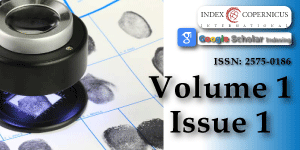Comparison of Vitreous Protein Profiles of Rabbits subjected to Acute Carbon Monoxide poisoning and normal animal after death
Main Article Content
Abstract
Acute carbon monoxide (CO) poisoning is caused by the inhalation of large quantity of CO within short time leading to morbidity and mortality. In this study, a total of eighteen (18) rabbits were divided into three (3) groups of six (6) animals each. The first group first group was poisoned with CO and labelled carbon monoxide death (CD). The second group of animals was killed prior to exposure to CO and labelled disguised death (DD), while the third was the control group (CG). The vitreous humour samples were collected from all the animals using standard methodologies. The vitreous humour total protein and albumin were estimated while its globulin content and albumin/globulin ratio were derived mathematically. Pearson correlation analyses were used to establish relationships between vitreous protein profile components and the acute graded carbon monoxide concentrations. Results indicated a significant increase (P<0.05) in vitreous total protein and globulin of the studied groups. This observation was more pronounced in the CD group of animals. Therefore the marked elevation of vitreous total protein and globulin may serve as a useful tool in the confirmation of death due to carbon monoxide poisoning.
Article Details
Copyright (c) 2017 Agoro ES, et al.

This work is licensed under a Creative Commons Attribution 4.0 International License.
Nageshkumar GR. Cardiac Poisons “In Textbook of Forensic Medicine and Toxicology”. Jaypee Brothers. 2006; 425-432. Ref.: https://goo.gl/4IL1Ap
Camps FE. Carbon monoxide poisoning accident, suicide and murder. Med Leg J. 1950; 18: 75-85. Ref.: https://goo.gl/iVwg6Y
Akaishi S, Oshida S, Hiraiwa K, Sebetan IM, Ohno Y, et al. Homicide and camouflaged carbon monoxide poisoning in Japan. Z Rechtsmed. 1982; 88: 298-304. Ref.: https://goo.gl/c4iZ66
Patel P, Scattler S. The Case Files: Carbon Monoxide Intoxication Disguised as Atrial Fibrillation. Emergency Medicine News. 2013; 35: 6. Ref.: https://goo.gl/3o1CNR
Mohammed A, Osama A, Maram A. Carbon monoxide toxicity in Dammam, KSA: Retrospective study. Egyptian Journal of Forensic Sciences. 2015; 5: 36-38. Ref.: https://goo.gl/zTz83q
Feng L, Heng C, Sihai L, Haipeng J, Hongjun L, et al. Carbon monoxide poisoning as a cause of death in Wuhan, China: A retrospective six-year epidemiological study (2009-2014). Forensic Science International. 2015; 253: 112-118. Ref.: https://goo.gl/m0StXE
San Juan County. Cause of two Islanders death comfirmed of carbon monoxide poisoning. Journal of the San Juan Islands. 2017. Ref.: https://goo.gl/u1Fa0d
Michael L. “Toxicology” In Laboratory Medicine: The Diagnosis of Disease in the Clinical Laboratory. First edititon. Mc Graw Hill LANGE. 2010; 167. Ref.: https://goo.gl/hEhDSx
Agoro ES, Okoye FBC, Azuonwu O, Ebiere NE. Extrapolation of Three Hourly Post-Mortem Interval using some Vitreous Chemistry Parameters. J Forensic Res. 2017; 8: 1-5. Ref.: https://goo.gl/Of0uaO
Agoro ES, Okoye FBC, Azuonwu O, Ebiere NE. The Effect of Age and Sex on Vitreous Humour Chemistry and Postmortem Interval (PMI). sss. 2017B; 6058.
Bosze Z, Houdebine LM. Application of rabbits in biomedical research: a review. World Rabbit Sci. 2006; 14: 1-14. Ref.: https://goo.gl/KBwesC
Alagoa EJ. The land and people of Bayelsa State: Central Niger Delta. Onyoma Research Publication. 2009. Ref.: https://goo.gl/KsD86z
Kirkwood J, Robert H. The UFAW Handbook on the Care and Management of Laboratory and Other Research Animals. Wiley-Blackwell. 2010; 29. Ref.: https://goo.gl/ErvSeg
Tente W, O’Rourke P, Sherman S, Kauper K, McGovern C, et al. Sustained Delivery of hCNTF to Rabbit Vitreous Humour by Two Polymer Encapsulated Cell Lines in the NT-502 Device. IO VS. 2004; 45. Ref.: https://goo.gl/fZTUdE
Coe JI. Vitreous potassium as a measure of the postmortem interval: an historical review and critical evaluation. Forensic Science International. 1989; 42: 201-213. Ref.: https://goo.gl/o15BW3
Peter TJ. Proposals for standardization of total serum protein assay. Clin Chem.1968; 14: 1147-1159. Ref.: https://goo.gl/OC3KI1
Michael LB, Janet LD, Edward PF. Amino Acids and Proteins. New York, 2nd edition, J.B. Lippincott Company. 1992.
Jakobiec A Frederick. Age related changes in vitreous structure, Principles and practice of ophthalmology 2nd edition. 2009; 1792-95.
Goldstein M. Carbon monoxide poisoning. J Emergency Nursing. 2008; 34: 538-542. Ref.: https://goo.gl/pkicih
Struttmann T, Scheerer A, Prince TS, Golden LA. Unintentional Carbon Monoxide Poisoning from an unlikely source. JABFM. 1998; 11: 481-484. Ref.: https://goo.gl/2HL2AT
Amith Mulla. Role of vitreous humour biochemistry in forensic pathology. University of Saskatchewan. 2005. Ref.: https://goo.gl/bbxmj4
Loh RK, Vale S, McLean-Tooke A. Quantitative serum innunoglobin tests. Aust Fam Physician. 2013; 42: 195-198. Ref.: https://goo.gl/4LGy1b
Hawkins KN. Contribution of plasma proteins to the vitreous of the rat. Curr Eye Res. 1986; 5: 655-663. Ref.: https://goo.gl/MXDNEV





